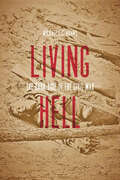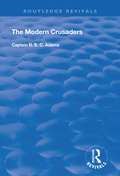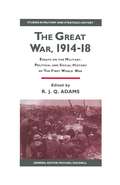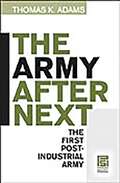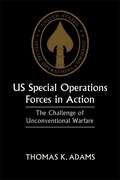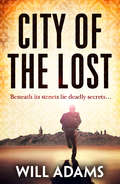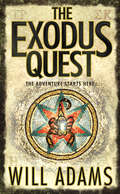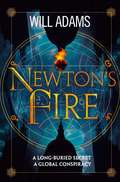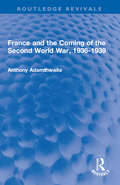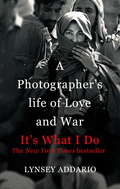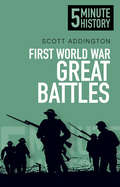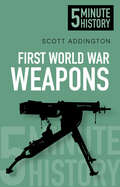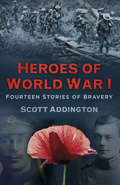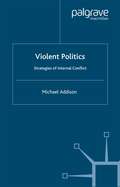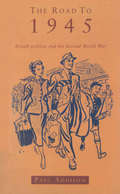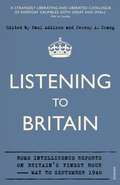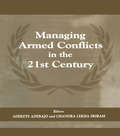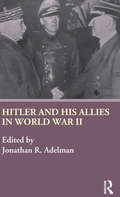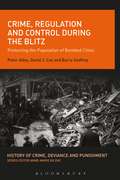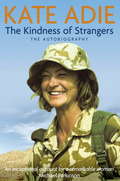- Table View
- List View
Living Hell: The Dark Side of the Civil War
by Michael C. C. AdamsMany Americans, argues Michael C. C. Adams, tend to think of the Civil War as more glorious, less awful, than the reality. Millions of tourists flock to battlefields each year as vacation destinations, their perceptions of the war often shaped by reenactors who work hard for verisimilitude but who cannot ultimately simulate mutilation, madness, chronic disease, advanced physical decay. In Living Hell, Adams tries a different tack, clustering the voices of myriad actual participants on the firing line or in the hospital ward to create a virtual historical reenactment.Perhaps because the United States has not seen conventional war on its own soil since 1865, the collective memory of its horror has faded, so that we have sanitized and romanticized even the experience of the Civil War. Neither film nor reenactment can fully capture the hard truth of the four-year conflict. Living Hell presents a stark portrait of the human costs of the Civil War and gives readers a more accurate appreciation of its profound and lasting consequences.Adams examines the sharp contrast between the expectations of recruits versus the realities of communal living, the enormous problems of dirt and exposure, poor diet, malnutrition, and disease. He describes the slaughter produced by close-order combat, the difficulties of cleaning up the battlefields;¢;‚¬;€?where tens of thousands of dead and wounded often lay in an area of only a few square miles;¢;‚¬;€?and the resulting psychological damage survivors experienced.Drawing extensively on letters and memoirs of individual soldiers, Adams assembles vivid accounts of the distress Confederate and Union soldiers faced daily: sickness, exhaustion, hunger, devastating injuries, and makeshift hospitals where saws were often the medical instrument of choice. Inverting Robert E. Lee;€™s famous line about war, Adams suggests that too many Americans become fond of war out of ignorance of its terrors. Providing a powerful counterpoint to Civil War glorification, Living Hell echoes William Tecumseh Sherman;€™s comment that war is cruelty and cannot be refined.Praise for Our Masters the Rebels: A Speculation on Union Military Failure in the East, 1861;€“1865"This excellent and provocative work concludes with a chapter suggesting how the image of Southern military superiority endured in spite of defeat.";¢;‚¬;€?Civil War History"Adams's imaginative connections between culture and combat provide a forceful reminder that Civil War military history belongs not in an encapsulated realm, with its own categories and arcane language, but at the center of the study of the intellectual, social, and psychological currents that prevailed in the mid-nineteenth century.";¢;‚¬;€?Journal of American HistoryPraise for The Best War Ever: America and World War II"Adams has a real gift for efficiently explaining complex historical problems.";¢;‚¬;€?Reviews in American History"Not only is this mythologizing bad history, says Adams, it is dangerous as well. Surrounding the war with an aura of nostalgia both fosters the delusion that war can cure our social ills and makes us strong again, and weakens confidence in our ability to act effectively in our own time.";¢;‚¬;€?Journal of Military History
The Modern Crusaders (Routledge Revivals)
by R. E. AdamsOriginally published in 1920. The 231st Infantry Brigade, with which this diary is chiefly concerned, came into extence in January 1917, at a time when its compoent parts were engaged in the campaign against the Senussi, distributed in the Western Desert of Egypt and the Oases, from Sollum to Dakhala. The diary opens on October 1st 1917, when the preparations for the simultaneous attacks on Beersheba and Gaza were nearing completion.
The Modern Crusaders (Routledge Revivals)
by R. E. AdamsOriginally published in 1920. The 231st Infantry Brigade, with which this diary is chiefly concerned, came into extence in January 1917, at a time when its compoent parts were engaged in the campaign against the Senussi, distributed in the Western Desert of Egypt and the Oases, from Sollum to Dakhala. The diary opens on October 1st 1917, when the preparations for the simultaneous attacks on Beersheba and Gaza were nearing completion.
The Great War, 1914–18: Essays on the Military, Political and Social History of the First World War (Studies in Military and Strategic History)
by R. J. Q. AdamsThe Great War is a collection of seven original essays and three critical comments by senior scholars dealing with the greatest conflict in modern history to its time - the 1914-18 World War. The Great War is edited by the distinguished historian of the First World War, R.J.Q.Adams.
The Army after Next: The First Postindustrial Army (Praeger Security International)
by Thomas K. AdamsThis book recounts the successes and failures of the US Army's Army Transformation program in the larger context of the Department of Defense's overall military transformation effort.Spurred by the belief that RMA represented the future, the Department of Defense (DoD) set out to transform the U.S. armed forces by adopting RMA concepts. Led by President George W. Bush and Defense Secretary Donald Rumsfeld, the DoD spent billions in an attempt to make the hypothetical capabilities real, changing the entire structure of the armed forces as a result. The services, the media, Congress, and the military industry each had its own agenda, all of which continue to come into play in the development of RMA strategies. The interplay of politics, technology, and military reality offers a fascinating narrative.Sure to be found controversial by some, compelling by all, this is the only available book-length examination of the way the U.S. Army and Department of Defense have tried to create the capabilities promised by the high-tech Revolution in Military Affairs. Of more immediate concern, it is also the only in-depth account of the effect RMA and transformation concepts had on the American operations in Afghanistan and Iraq. Many of the problems in both Iraq and Afghanistan, author Thomas K. Adams argues, arose from the DoD's implacable desire to implement RMA-driven transformation concepts—whether they were appropriate or not. What we need to do, he maintains, is to fight the war we have, not the war we want.
US Special Operations Forces in Action: The Challenge of Unconventional Warfare
by Thomas K. AdamsArmies in the 1990s are commonly involved in low-level, ill-defined, politically charged, messy situations known collectively as "unconventional warfare". Thomas Adams argues for a shift in expectations with a greater willingness to accept lengthy commitments and incremental progress.
US Special Operations Forces in Action: The Challenge of Unconventional Warfare
by Thomas K. AdamsArmies in the 1990s are commonly involved in low-level, ill-defined, politically charged, messy situations known collectively as "unconventional warfare". Thomas Adams argues for a shift in expectations with a greater willingness to accept lengthy commitments and incremental progress.
City of the Lost
by Will AdamsA high-stakes thriller which weaves Turkey’s war-torn past with action, adventure and conspiracy.
The Exodus Quest (Daniel Knox Ser. #2)
by Will AdamsFact collides with fiction in Will Adams second pulse-pounding adventure featuring the enigmatic Daniel Knox.
Newton’s Fire
by Will AdamsA breathtaking thriller which weaves history and religion with action, adventure and apocalypse…
France and the Coming of the Second World War, 1936-1939 (Routledge Revivals)
by Anthony AdamthwaiteFirst published in 1977, France and the Coming of the Second World War investigates the policies that led to the collapse of French power. The book argues that this collapse was the result of social, political, and economic troubles that buffeted French leaders. It uses a wealth of documents to explore common debates, such as Britain’s culpability for France’s inability to prevent Germany’s reoccupation of the Rhineland. It also puts forward the threat of Italy and the Mediterranean as France’s main preoccupation, rather than Germany and central Europe. France and the Coming of the Second World War uses an extensive range of archival material and includes the private papers of Daladier, Bonnet, and a number of other prominent figures. It will appeal to those with an interest in the history of the Second World War, political history, and social history.
France and the Coming of the Second World War, 1936-1939 (Routledge Revivals)
by Anthony AdamthwaiteFirst published in 1977, France and the Coming of the Second World War investigates the policies that led to the collapse of French power. The book argues that this collapse was the result of social, political, and economic troubles that buffeted French leaders. It uses a wealth of documents to explore common debates, such as Britain’s culpability for France’s inability to prevent Germany’s reoccupation of the Rhineland. It also puts forward the threat of Italy and the Mediterranean as France’s main preoccupation, rather than Germany and central Europe. France and the Coming of the Second World War uses an extensive range of archival material and includes the private papers of Daladier, Bonnet, and a number of other prominent figures. It will appeal to those with an interest in the history of the Second World War, political history, and social history.
It's What I Do: A Photographer's Life of Love and War
by Lynsey AddarioWar photographer Lynsey Addario's memoir It's What I Do is the story of how the relentless pursuit of truth, in virtually every major theatre of war in the twenty-first century, has shaped her life. Lynsey Addario was just finding her way as a photographer when September 11th changed the world. One of the few photojournalists with experience in Afghanistan, when she is asked to return and cover the American invasion, she makes a decision - not to stay home, not to lead a quiet or predictable life, but to set out across the world, face the chaos of crisis, and make a name for herself. Addario travels with purpose and bravery, photographing the Afghan people before and after the Taliban reign, the civilian casualties and misunderstood insurgents of the Iraq War, as well as the burned villages and countless dead in Darfur. She exposes a culture of violence against women in the Congo and tells the riveting story of her headline-making kidnapping by pro-Qaddafi forces in the Libyan civil war.As a woman photojournalist Addario is determined to be taken as seriously as her male peers. She fights her way into a boys' club of a profession; and once there, rather than choose between her personal life and her career, Addario learns to strike a necessary balance. Watching uprisings unfold and people fight to the death for their freedom, Addario understands she is documenting not only news but also the fate of society. It's What I Do is more than just a snapshot of life on the front lines; it bears witness to the human cost of war.
First World War Great Battles: 5 Minute History (5 Minute History Ser.)
by Scott AddingtonHow did the First World War start? Who were the main players? Where did the fighting begin? And why were there so many casualties? If the 100-year anniversary of this war to end all wars has left you feeling a little under-informed, Five Minute History is the perfect way to read up on this major conflict in short bursts and without pages of intricate detail. A perfect overview for the uninitiated, each book will inform and educate you of the ups and downs of the First World War even if you have never read a history book in your life.
First World War Weapons: 5 Minute History (5 Minute History Ser.)
by Scott AddingtonHow did the First World War start? Who were the main players? Where did the fighting begin? And why were there so many casualties? If the 100-year anniversary of this war to end all wars has left you feeling a little under-informed, Five Minute History is the perfect way to read up on this major conflict in short bursts and without pages of intricate detail. A perfect overview for the uninitiated, each book will inform and educate you of the ups and downs of the First World War even if you have never read a history book in your life.
Heroes of World War I: Fourteen Stories of Bravery
by Scott AddingtonThese are the stories of fourteen men whose lives were changed the day that telegram arrived. In 1914 they were accountants, shopkeepers and labourers. When they were called to arms they became soldiers, sailors and airmen, fighting in the mud of the trenches, navigating the high seas or flying in the very first aerial war. Miles from their homes and families, they were pushed to their very limits and forever changed by what they experienced. Not all of them came back again. In Heroes of World War I Scott Addington tells the long-forgotten stories of fourteen brave men who rallied for their country. The voice of the ordinary soldier is typically overlooked by memories and histories of the First World War, and so this book is a tribute to them.
Violent Politics: Strategies of Internal Conflict (St Antony's Series)
by M. AddisonViolent politics in Northern Ireland has lasted thirty years and cost four thousand lives and billions of pounds. Many such conflicts afflict the world. This book describes the search for causes and solutions. It identifies the key factors driving violent politics and the range of counter-strategies. It analyzes the course of the troubles in Northern Ireland, and the results of the countermeasures used. The conclusions are disturbing. The recommendations are controversial, but difficult to escape.
The Road To 1945: British Politics and the Second World War Revised Edition
by Paul AddisonThe Road to 1945 is a rigorously researched study of the crucial moment when political parties put aside their differences to unite under Churchill and focus on the task of war. But the war years witnessed a radical shift in political power - dramatically expressed in Labour's decisive electoral victory in 1945. In his acclaimed study, Paul Addison reconstructs and interprets the five-year wartime coalition, and traces this sea-change from its roots in the thirties, to the powerful spirit of post-war rebuilding.The Road to 1945 is an imaginative, brilliantly written and landmark work, underpinned by a powerful and expertly researched argument.
Listening to Britain: Home Intelligence Reports on Britain's Finest Hour, May-September 1940
by Paul Addison Jeremy A CrangFrom May to September 1940, a period that saw some of the most dramatic events in British history - including the evacuation of Dunkirk, the Battle of Britain and the opening stages of the Blitz - the Ministry of Information eavesdropped on the conversations of ordinary people in all parts of the United Kingdom and compiled secret daily reports on the state of popular morale.
Managing Armed Conflicts in the 21st Century
by Adekeye Adebajo Chandra Lekha SriramProduced with the International Peace Academy in New York, this volume focuses largely on the conflicts of the 1990s and future projects, examining multifacteted issues involved in conflict management, suggesting new approaches and tools for future conflict management.
Managing Armed Conflicts in the 21st Century
by Adekeye Adebajo Chandra Lekha SriramProduced with the International Peace Academy in New York, this volume focuses largely on the conflicts of the 1990s and future projects, examining multifacteted issues involved in conflict management, suggesting new approaches and tools for future conflict management.
Hitler and His Allies in World War Two
by Jonathan R. AdelmanIn an area where in-depth studies of Hitler's relations with Nazi Germany's allies, and the failure of Nazi Germany to make more effective use of them during the war, are scant, this is a survey that looks at the Soviet Union, Japan, France, Italy, Spain, Romania and Hungary and their relationship to Nazi Germany. Using a comparative approach, seven case studies examine themes such as co-operation and resistance, military and economic aid, treatment of Jews, relations with the enemies and the popular sentiment towards Germany. Jonathan Adelman has provided students of the Second World War with a welcome mine of information and a unique perspective on a much-studied topic.
Crime, Regulation and Control During the Blitz: Protecting the Population of Bombed Cities (History of Crime, Deviance and Punishment)
by Peter Adey David J. Cox Barry GodfreyCrime, Regulation and Control during the Blitz looks at the social effect of bombing on urban centres like Liverpool, Coventry and London, critically examining how the wartime authorities struggled to regulate and control crime and offending during the Blitz. Focusing predominantly on Liverpool, it investigates how the authorities and citizens anticipated the aerial war, and how the State and local authorities proposed to contain and protect a population made unruly, potentially deviant and drawn into a new landscape of criminal regulation.Drawing on a range of contemporary sources, the book throws into relief today's experiences of war and terror, the response in crime and deviancy, and the experience and practices of preparedness in anticipation of terrible threats. The authors reveal how everyday activities became criminalised through wartime regulations and explore how other forms of crime such as looting, theft and drunkenness took on a new and frightening aspect. Crime, Regulation and Control during the Blitz offers a critical contribution to how we understand crime, security, and regulation in both the past and the present.
Crime, Regulation and Control During the Blitz: Protecting the Population of Bombed Cities (History of Crime, Deviance and Punishment)
by Peter Adey David J. Cox Barry GodfreyCrime, Regulation and Control during the Blitz looks at the social effect of bombing on urban centres like Liverpool, Coventry and London, critically examining how the wartime authorities struggled to regulate and control crime and offending during the Blitz. Focusing predominantly on Liverpool, it investigates how the authorities and citizens anticipated the aerial war, and how the State and local authorities proposed to contain and protect a population made unruly, potentially deviant and drawn into a new landscape of criminal regulation.Drawing on a range of contemporary sources, the book throws into relief today's experiences of war and terror, the response in crime and deviancy, and the experience and practices of preparedness in anticipation of terrible threats. The authors reveal how everyday activities became criminalised through wartime regulations and explore how other forms of crime such as looting, theft and drunkenness took on a new and frightening aspect. Crime, Regulation and Control during the Blitz offers a critical contribution to how we understand crime, security, and regulation in both the past and the present.
The Autobiography: The Autobiography
by Kate AdieKate Adie's story is an unusual one. Raised in post-war Sunderland, where life was 'a sunny experience, full of meat-paste sandwiches and Sunday school', she has reported memorably and courageously from many of the world's trouble spots since she joined the BBC in 1969. THE KINDNESS OF STRANGERS encompasses Adie's reporting from, inter alia, Northern Ireland, the Middle East, Tiananmen Square and, of course, the Gulf War of 1991. It offers a compelling combination of vivid frontline reporting and evocative writing and reveals the extraordinarily demanding life of the woman who is always at the heart of the action. Although an intensely private person, Kate Adie also divulges what it's like to be a woman in a man's world - an inspiration to many working women.
